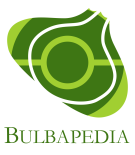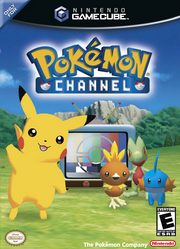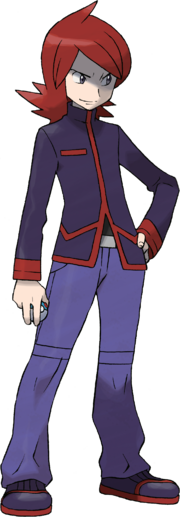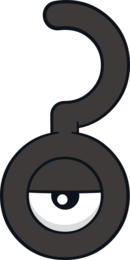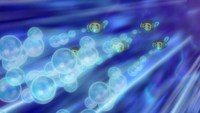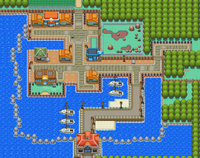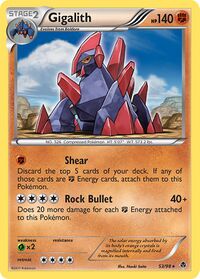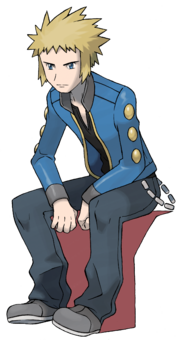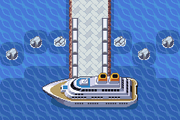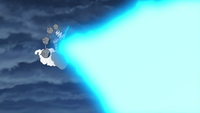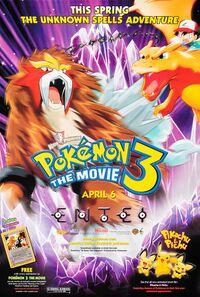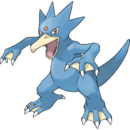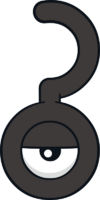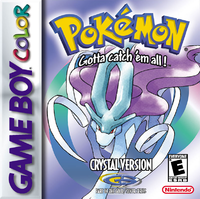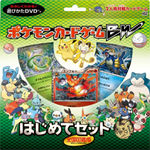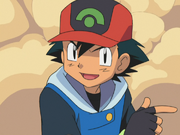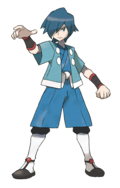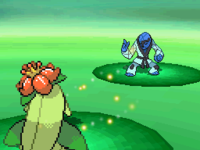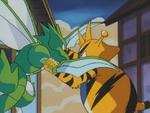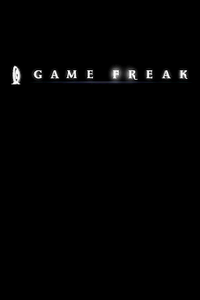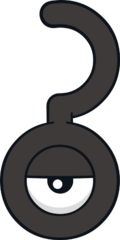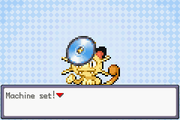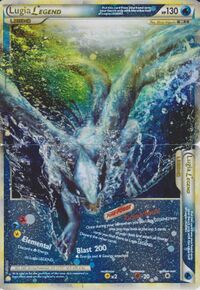Bulbapedia:Featured content/Archive/April 2012: Difference between revisions
From Bulbapedia, the community-driven Pokémon encyclopedia.
Jump to navigationJump to search
Force Fire (talk | contribs) No edit summary |
Tiddlywinks (talk | contribs) m (→Friday April 6, 2012: Blaze: relink) |
||
| (19 intermediate revisions by 10 users not shown) | |||
| Line 12: | Line 12: | ||
* In 2009 there was no prank due to server issues. | * In 2009 there was no prank due to server issues. | ||
* In 2010, Bulbapedia became Slowpedia "the sluggish and mellow Pokémon encyclopedia", complete with Slowpoke family imagery and pink Slowpoke colors throughout the site. | * In 2010, Bulbapedia became Slowpedia "the sluggish and mellow Pokémon encyclopedia", complete with Slowpoke family imagery and pink Slowpoke colors throughout the site. | ||
* In 2011, Bulbapedia became Fushigipedia, "the Pocket Monster encyclopedia", complete with Generation I colors, references, and imagery of Pokémon throughout the site. The featured article was [ | * In 2011, Bulbapedia became Fushigipedia, "the Pocket Monster encyclopedia", complete with Generation I colors, references, and imagery of Pokémon throughout the site. The featured article was [http://web.archive.org/web/20110407085839/https://bulbapedia.bulbagarden.net/wiki/Appendix:Game_Boy Game Boy], rewritten for 1998. To coincide with the Bulbasaur theme of Bulbapedia, the romanization derivation is taken from Bulbasaur's name, Fushigidane. | ||
<center> | <center> | ||
So, what will our prank be this year? We can't tell you that. | So, what will our prank be this year? We can't tell you that. | ||
| Line 19: | Line 19: | ||
{{-}} | {{-}} | ||
==Monday April 2, 2012: Pokémon Channel== | ==Monday April 2, 2012: Pokémon Channel== | ||
[[File: | [[File:Channel EN boxart.png|right|180px]] | ||
===Touch That Remote: Pokémon Channel=== | ===Touch That Remote: Pokémon Channel=== | ||
* '''Pokémon Channel''' (Japanese: '''ポケモンチャンネル ~ピカチュウといっしょ!~''' ''Pokémon Channel ~Together With Pikachu!~'') is a spin-off game for the [[Nintendo GameCube]]. In 2003, it had a Japanese release of July 18 and North American release of December 1. It had a European exactly eight years ago on April 2, 2004. | * '''Pokémon Channel''' (Japanese: '''ポケモンチャンネル ~ピカチュウといっしょ!~''' ''Pokémon Channel ~Together With Pikachu!~'') is a spin-off game for the [[Nintendo GameCube]]. In 2003, it had a Japanese release of July 18 and North American release of December 1. It had a European exactly eight years ago on April 2, 2004. | ||
| Line 34: | Line 34: | ||
===Character of the day: Silver=== | ===Character of the day: Silver=== | ||
* '''Silver''' (Japanese: '''シルバー''' ''Silver'') is the main [[Rival|rival]] of the [[Generation II]] games and its [[Pokémon HeartGold and SoulSilver Versions|remakes]]. He is a rather cruel and abusive person only wanting Pokémon that he deems are strong and despises weak Pokémon and weak Trainers. | * '''Silver''' (Japanese: '''シルバー''' ''Silver'') is the main [[Rival|rival]] of the [[Generation II]] games and its [[Pokémon HeartGold and SoulSilver Versions|remakes]]. He is a rather cruel and abusive person only wanting Pokémon that he deems are strong and despises weak Pokémon and weak Trainers. | ||
* It was revealed in [[Pokémon Adventures]] that [[Giovanni]] is his father, this was later proven in HeartGold and SoulSilver via an [[List of | * It was revealed in [[Pokémon Adventures]] that [[Giovanni]] is his father, this was later proven in HeartGold and SoulSilver via an [[List of event Pokémon with in-game effects#Celebi|event]] where it shows Giovanni leaving Silver after his failure with [[Team Rocket]]. Because of this, Silver dislikes Team Rocket seeing them as weak. | ||
* While Silver never made a full anime appearance, he briefly appeared in the Japanese opening of ''[[The Legend of Thunder!]]'' ([[A New Oath]]). However, [[Paul]] can be seen as an inspiration of Silver as both have similar appearance and personalities. | * While Silver never made a full anime appearance, he briefly appeared in the Japanese opening of ''[[The Legend of Thunder!]]'' ([[A New Oath]]). However, [[Paul]] can be seen as an inspiration of Silver as both have similar appearance and personalities. | ||
| Line 61: | Line 61: | ||
[[File:Tympole BubbleBeam.png|right|200px]] | [[File:Tympole BubbleBeam.png|right|200px]] | ||
===Your move: BubbleBeam=== | ===Your move: BubbleBeam=== | ||
* '''BubbleBeam''' (Japanese: '''バブルこうせん''' ''Bubble Beam'') is a damage-dealing {{ | * '''BubbleBeam''' (Japanese: '''バブルこうせん''' ''Bubble Beam'') is a damage-dealing {{type|Water}} [[move]] introduced in [[Generation I]]. It was available as [[TM11]] in said Generation and was awarded for defeating [[Misty]]. | ||
* Every Pokémon that learn this move by level gains [[Same-type attack bonus|STAB]] from it. | * Every Pokémon that learn this move by level gains [[Same-type attack bonus|STAB]] from it. | ||
* BubbleBeam is a variation on the move {{m|Aurora Beam}} | * BubbleBeam is a variation on the move {{m|Aurora Beam}} | ||
* This move affects anyone adjacent to the user. | * This move affects anyone adjacent to the user. | ||
* BubbleBeam has appeared in the [[Pokémon Trading Card Game]] 16 times; first on {{TCG ID|Base Set|Gyarados|6}} from {{TCG|Base Set}}, and most recently on the {{TCG ID|Reshiram EX Strength Deck|Palpitoad|8}} from the Japanese {{TCG|Reshiram EX Battle Strength Deck}}. It Paralyzes the Defending Pokémon with the success of a coin flip. | * BubbleBeam has appeared in the [[Pokémon Trading Card Game]] 16 times; first on {{TCG ID|Base Set|Gyarados|6}} from {{TCG|Base Set}}, and most recently on the {{TCG ID|Reshiram-EX Strength Deck|Palpitoad|8}} from the Japanese {{TCG|Reshiram-EX Battle Strength Deck}}. It Paralyzes the Defending Pokémon with the success of a coin flip. | ||
<center>{{m|BubbleBeam|Read more...}}</center> | <center>{{m|BubbleBeam|Read more...}}</center> | ||
| Line 72: | Line 72: | ||
[[File:Ash Infernape Blaze.png|right|250px]] | [[File:Ash Infernape Blaze.png|right|250px]] | ||
===Know your ability: Blaze=== | ===Know your ability: Blaze=== | ||
* '''Blaze''' (Japanese: '''もうか''' ''Raging Flames'') is an Ability introduced in [[Generation III]]. Seventeen Pokémon can have this Ability, a majority of them are [[starter Pokémon]]. | * '''Blaze''' (Japanese: '''もうか''' ''Raging Flames'') is an Ability introduced in [[Generation III]]. Seventeen Pokémon can have this Ability, a majority of them are [[first partner Pokémon|starter Pokémon]]. | ||
* When a Pokémon with Blaze uses a {{ | * When a Pokémon with Blaze uses a {{type|Fire}} [[move]], the power will increase by 1.5× if the user has less than or equal to ⅓ of its maximum HP remaining. | ||
* Blaze is one of the four variations of the ability {{a|Overgrow}}. | * Blaze is one of the four variations of the ability {{a|Overgrow}}. | ||
* Blaze was first used in the anime in ''[[AG191|Once More with Reeling!]]'' by [[May's Blaziken]] in a contest battle with [[Ash's Sceptile]]. [[Ash's Infernape]] would activate Blaze in numerous battles in all stages of its evolution. | * Blaze was first used in the anime in ''[[AG191|Once More with Reeling!]]'' by [[May's Blaziken]] in a contest battle with [[Ash's Sceptile]]. [[Ash's Infernape]] would activate Blaze in numerous battles in all stages of its evolution. | ||
| Line 81: | Line 81: | ||
<center>[[Blaze (ability)|Read more...]]</center> | <center>[[Blaze (ability)|Read more...]]</center> | ||
{{-}} | {{-}} | ||
==Saturday April 7, 2012: Pokémon Musical== | ==Saturday April 7, 2012: Pokémon Musical== | ||
[[File:Pokémon Musical logo.png|right|200px]] | [[File:Pokémon Musical logo.png|right|200px]] | ||
| Line 112: | Line 113: | ||
===Tourist Spot: Vermilion City=== | ===Tourist Spot: Vermilion City=== | ||
* '''Vermilion City''' (Japanese: '''クチバシティ''' ''Kuchiba City'') is a city in [[Kanto]]. Situated near a sea inlet to the south, it serves as a popular sea port for ships such as the [[S.S. Anne]]. Vermilion Harbor is a home port for many ships. | * '''Vermilion City''' (Japanese: '''クチバシティ''' ''Kuchiba City'') is a city in [[Kanto]]. Situated near a sea inlet to the south, it serves as a popular sea port for ships such as the [[S.S. Anne]]. Vermilion Harbor is a home port for many ships. | ||
* Vermilion City is home to the {{ | * Vermilion City is home to the {{type|Electric}} [[Vermilion Gym]] with [[Gym Leader]] [[Lt. Surge]]. | ||
* Vermilion City is also home to the [[Pokémon Fan Club]] where the [[Pokémon Fan Club Chairman|Fan Club Chairman]] will award the player with a [[List of key items in Generation III#Bike Voucher|bike voucher]]{{sup|RBY}}{{sup|FRLG}} or a [[Vitamin#Rare Candy|Rare Candy]]{{sup|GSC}}{{sup|HGSS}}. | * Vermilion City is also home to the [[Pokémon Fan Club]] where the [[Pokémon Fan Club Chairman|Fan Club Chairman]] will award the player with a [[List of key items in Generation III#Bike Voucher|bike voucher]]{{sup/1|RBY}}{{sup/3|FRLG}} or a [[Vitamin#Rare Candy|Rare Candy]]{{sup/2|GSC}}{{sup/4|HGSS}}. | ||
* Vermilion City made its sole anime appearance in ''[[EP014|Electric Shock Showdown]]'' where {{Ash}} battled Lt. Surge for the {{badge|Thunder}}. | * Vermilion City made its sole anime appearance in ''[[EP014|Electric Shock Showdown]]'' where {{Ash}} battled Lt. Surge for the {{badge|Thunder}}. | ||
* An in game trade allows players to obtain a {{p|Farfetch'd}} for a {{p|Spearow}}. | * An in game trade allows players to obtain a {{p|Farfetch'd}} for a {{p|Spearow}}. | ||
| Line 167: | Line 168: | ||
* This episode introduced the most named, recurring characters in the entire anime. However, given that it introduced Brock's siblings, it has an advantage over other episodes. If all of Gary's cheerleaders had ever been named, the honor would go to the first episode. | * This episode introduced the most named, recurring characters in the entire anime. However, given that it introduced Brock's siblings, it has an advantage over other episodes. If all of Gary's cheerleaders had ever been named, the honor would go to the first episode. | ||
* This is one of the few episodes where Ash tries to return {{AP|Pikachu}} to its [[Poké Ball]]. | * This is one of the few episodes where Ash tries to return {{AP|Pikachu}} to its [[Poké Ball]]. | ||
* This episode is featured on the ''Volume 20: Onix'' copy of | * This episode is featured on the ''Volume 20: Onix'' copy of {{OBP|Pokémon All-Stars|Region 4}}. | ||
<center>[[EP005|Read more...]]</center> | <center>[[EP005|Read more...]]</center> | ||
{{-}} | {{-}} | ||
==Saturday April 14, 2012: S.S. Anne== | ==Saturday April 14, 2012: S.S. Anne== | ||
[[File:SS Anne FRLG.png|right|180px]] | [[File:SS Anne FRLG.png|right|180px]] | ||
| Line 239: | Line 241: | ||
{{-}} | {{-}} | ||
==Thursday April 19, 2012: Pokémon Crystal Version== | ==Thursday April 19, 2012: Pokémon Crystal Version== | ||
[[File: | [[File:Crystal EN boxart.png|200px|right]] | ||
===Know Your Game: Pokémon Crystal Version=== | ===Know Your Game: Pokémon Crystal Version=== | ||
* '''Pokémon Crystal Version''' (Japanese: '''ポケットモンスター クリスタルバージョン''' ''Pocket Monsters Crystal Version'') is the sixth Pokémon game in the main series; however, in Japan it was actually the seventh Pokémon game. It was released as a sister game of [[Pokémon Gold and Silver Versions|Pokémon Gold and Silver]], which were released one year before. | * '''Pokémon Crystal Version''' (Japanese: '''ポケットモンスター クリスタルバージョン''' ''Pocket Monsters Crystal Version'') is the sixth Pokémon game in the main series; however, in Japan it was actually the seventh Pokémon game. It was released as a sister game of [[Pokémon Gold and Silver Versions|Pokémon Gold and Silver]], which were released one year before. | ||
| Line 271: | Line 273: | ||
===Spotlight on: Unbeatable=== | ===Spotlight on: Unbeatable=== | ||
* Unbeatable is the opening theme to the eighth [[season]] of the English-language Pokémon dub, [[Pokémon: Advanced Battle]]. It was used from ''[[AG093|Clamperl of Wisdom]]'' to ''[[AG145|Pasta La Vista!]]'' as well as in the movie ''[[M08|Lucario and the Mystery of Mew]]''. | * Unbeatable is the opening theme to the eighth [[season]] of the English-language Pokémon dub, [[Pokémon: Advanced Battle]]. It was used from ''[[AG093|Clamperl of Wisdom]]'' to ''[[AG145|Pasta La Vista!]]'' as well as in the movie ''[[M08|Lucario and the Mystery of Mew]]''. | ||
* It was written and produced by [[John Siegler]] and [[David Rolfe]]. David Rolfe also sung the song. It was the 8th track on the album | * It was written and produced by [[John Siegler]] and [[David Rolfe]]. David Rolfe also sung the song. It was the 8th track on the album {{OBP|Pokémon X|CD}}. | ||
* The opening animation featured footage from the eighth and ninth Japanese openings, [[Pokémon Symphonic Medley]] and [[Battle Frontier (song)|Battle Frontier]]. | * The opening animation featured footage from the eighth and ninth Japanese openings, [[Pokémon Symphonic Medley]] and [[Battle Frontier (song)|Battle Frontier]]. | ||
* Due to having animation from Battle Frontier, this opening revealed three new Pokémon: {{p|Mime Jr.}}, {{p|Weavile}} (neither of whom had official English names yet at the time), and {{p|Lucario}} to international audiences. However, all three were later removed in ''[[AG105|Once in a Mawile]]''. | * Due to having animation from Battle Frontier, this opening revealed three new Pokémon: {{p|Mime Jr.}}, {{p|Weavile}} (neither of whom had official English names yet at the time), and {{p|Lucario}} to international audiences. However, all three were later removed in ''[[AG105|Once in a Mawile]]''. | ||
| Line 280: | Line 282: | ||
{{-}} | {{-}} | ||
==Sunday April 22, 2012: == | |||
==Sunday April 22, 2012: Falkner== | |||
[[File:HeartGold SoulSilver Falkner.png|right|120px]] | [[File:HeartGold SoulSilver Falkner.png|right|120px]] | ||
===Character of the Day: Falkner=== | ===Character of the Day: Falkner=== | ||
| Line 294: | Line 297: | ||
{{-}} | {{-}} | ||
==Monday April 23, 2012: Mega Drain== | ==Monday April 23, 2012: Mega Drain== | ||
[[File:Mega Drain.png|right|200px]] | [[File:Mega Drain V.png|right|200px]] | ||
===Your move: Mega Drain=== | ===Your move: Mega Drain=== | ||
* '''Mega Drain''' (Japanese: '''メガドレイン''' ''Mega Drain'') is a damage-dealing {{type|Grass}} move introduced in [[Generation I]]. It was [[TM21]] in that Generation. It was then replaced by {{m|Frustration}} in [[Generation II]]. | * '''Mega Drain''' (Japanese: '''メガドレイン''' ''Mega Drain'') is a damage-dealing {{type|Grass}} move introduced in [[Generation I]]. It was [[TM21]] in that Generation. It was then replaced by {{m|Frustration}} in [[Generation II]]. | ||
| Line 306: | Line 309: | ||
{{-}} | {{-}} | ||
==Tuesday April 24, 2012: Showdown at Dark City== | |||
[[File:EP042.png|right|150px]] | |||
===Remember That Episode?: Showdown at Dark City=== | |||
* '''Showdown at Dark City''' (Japanese: '''たいけつ!ポケモンジム!''' ''Showdown! Pokémon Gym!'') is the 42nd episode of the [[Pokémon anime]]. It was first broadcast in Japan on April 30, 1998, and in the United States on October 29, 1998. | |||
* In this episode, {{Ash}} and {{ashfr|co.}} arrives in [[Dark City]] which appears to be abandoned. It is then revealed that the area has two [[Kaz|rival]] [[Yas|Gyms]] at war planning to become an official Gym. | |||
* In this episode, Ash's {{AP|Pikachu}} is revealed to know {{m|Thunder}}. | |||
* This episode marked the debut of the following Pokémon: {{p|Electabuzz}}, {{p|Scyther}}, {{p|Rhydon}} and {{p|Kingler}} | |||
* Pikachu's fondness of ketchup is revealed in this episode. | |||
* This episode reveals Electabuzz and Scyther's apparent dislike towards the color red, though ironically, they were both [[version-exclusive Pokémon|exclusive to]] Pokémon Red when only the original two games had been released. Their evolutions, {{p|Electivire}} and {{p|Scizor}}, also have some red coloration, with Scizor being nearly completely red in color. | |||
<center>[[EP042|Read more...]]</center> | |||
{{-}} | {{-}} | ||
==Wednesday April 25, 2012: == | ==Wednesday April 25, 2012: Scizor== | ||
[[File:212Scizor.png|100px|right]] | |||
===Gotta Catch 'em All!: Scizor=== | |||
* '''Scizor''' (Japanese: '''ハッサム''' Hassam) is a dual-type {{2t|Bug|Steel}} Pokémon. It [[Evolution|evolves]] from {{p|Scyther}} when [[trade]]d holding a {{DL|Type-enhancing item|Metal Coat}}. | |||
* It is number 212 in the National dex, 112{{tt|*|111 in Generation II}} in the Johto dex and #196 in the extended Sinnoh dex in {{v|Platinum}}. | |||
* Scizor can have the ability {{a|Swarm}} or {{a|Technician}} and has {{a|Light Metal}} as its hidden ability. | |||
* Scizor its anime debut in ''[[EP140|Wired For Battle]]'' under the ownership of [[Shingo]]. In the same episode, the trainer [[Muramasa]] has a Scizor named Masamune. | |||
* Scizor has appeared in [[Super Smash Bros. Melee]] as a Pokéball Pokémon. When released it violently tackle the opponent of the stage. | |||
* Scizor is first seen in {{PAV|9}} under the control of {{adv|Blue}}, having evolved from his {{TP|Blue|Scyther}} prior to the events of the volume. He brings it on his journey to the [[Sevii Islands]]. | |||
* {{TCG|Scizor}} has been featured on {{#expr: {{PAGESINCATEGORY:Scizor (TCG)}} - 1}} different cards since it debuted in the {{TCG|Neo Discovery}} expansion of the [[Pokémon Trading Card Game]]. Scizor cards are normally {{ct|Metal}} or {{ct|Grass}} {{TCG|Stage 1 Pokémon}}. | |||
<center>{{p|Scizor|Read more...}}</center> | |||
{{-}} | {{-}} | ||
==Thursday April 26, 2012: == | ==Thursday April 26, 2012: Game Freak anniversary== | ||
[[File:Game Freak logo BWB2W2.png|200px|right]] | |||
===Happy Anniversary, Game Freak!=== | |||
* '''Game Freak, Inc.''' (Japanese: '''株式会社ゲームフリーク''' ''{{wp|Kabushiki gaisha}} Game Freak'') is a Japanese game development company founded on April 26, 1989 by [[Satoshi Tajiri]], [[Ken Sugimori]], and [[Junichi Masuda]], and the main company responsible for the [[Pokémon]] games, most especially the [[main series|main series versions]]. | |||
* Originally independent, since the release of {{game|Red and Green|s}} in 1996, Game Freak has been a {{wp|second-party developer}} for [[Nintendo]], developing games exclusively for their hardware while remaining a separate company. | |||
* Game Freak, at the time unincorporated, originated as a video game magazine in the early 1980's. Run chiefly by Tajiri, with art made by Sugimori, the magazines typically were released at a length of around 28 pages and at a price of ¥300 (roughly US$3). | |||
* Though the idea for what would become the Pokémon games had existed in Tajiri's mind for a while, actual development of the Pokémon idea began as [[Capsule Monsters]] in 1990. | |||
* Though Game Freak has mainly developed the Pokémon series since its 1996 debut, it is responsible for two games released since then that were not Pokémon-related. [http://www.youtube.com/watch?v=aDqSZub7Dag Click + Medic], a Japan-only medical simulation game for the {{wp|PlayStation}}, plays similarly to Pokémon, though instead of monsters, features a doctor using various vaccines and antibodies to fight against viruses and other maladies inside of a patient's body. | |||
* Game Freak employees appear in each of the main series games, with their headquarters on the third floor of the [[Celadon Condominiums]]. In the games in which [[Kanto]] is not visitable, they appear on vacation, with a group in [[Lilycove City]], staying in the [[Cove Lily Motel]], and a single member staying at the [[Hotel Grand Lake]] in [[Valor Lakefront]]. The main reason to visit them is to obtain a [[diploma]], awarded after the completion of the [[Pokédex]]. | |||
* Game Freak has its own building in [[Castelia City]] in {{game|Black and White|s}}, where a character representing [[Shigeki Morimoto]] can be battled after stopping [[Team Plasma]]. Game Freak is found on 22F, just like in their real-world office in {{wp|Carrot Tower}}. | |||
<center> | |||
[[Game Freak|Read more...]] | |||
</center> | |||
{{-}} | {{-}} | ||
==Friday April 27, 2012: Who's That Pokémon!? Ninetales== | |||
[[File:201Unown Question Dream.png|right|120px]] | |||
===Who's That Pokémon!?=== | |||
* You may ground me down but I'll melt you away. | |||
* If you mistreat me, I will lay a curse that will last years. | |||
* I can live for a very long time. | |||
* I am based of a famous Japanese legend. | |||
* My pre-evolution was owned by a main character. | |||
* My name refers to my anatomy. | |||
<center>{{p|Ninetales|Give up?}}</center> | |||
{{-}} | {{-}} | ||
==Saturday April 28, 2012: == | ==Saturday April 28, 2012: Technical Machines (TM)== | ||
[[File:TM set FRLG.png|right|180px]] | |||
===Trainer's Guide: Technical Machines=== | |||
* A '''Technical Machine''', or '''TM''' for short (Japanese: '''わざマシン''' ''Move Machine''), is a machine used by [[Pokémon Trainer]]s to teach a Pokémon a new [[move]] that it might not otherwise learn. | |||
* Up until [[Generation V]], TMs were good for only one use, unlike [[HM|Hidden Machines]], which can be used over and over again on many different Pokémon. | |||
* TMs can be found on the ground or bought at department stores. Some are also given away by [[Gym Leaders]] as prizes for defeating them in addition to a [[Badge]]. | |||
* There are currently 95 TMs in the games. In [[Generation I]] to [[Generation III]] there were 50 TMs though the moves the TMs contained would change over the generations. In [[Generation IV]] the TM list was expanded to 92 with the 50 TMs from Generation III remaining the same. | |||
* TMs play a similar role the the [[Pokémon Trading Card Game|TCG]] as most have a compatibility requirements and all those released before {{TCG|Legends Awakened}} are to be discarded from the Pokémon at the end of the turn they were played. These cards first saw a release in {{TCG|Pokémon VS}}; however, international audiences did not have access to them until the {{TCG|Expedition Base Set}}. | |||
* TMs [[TM06|06]], [[TM14|14]], [[TM15|15]], [[TM22|22]], [[TM25|25]], [[TM26|26]], [[TM28|28]], [[TM29|29]], [[TM32|32]], [[TM38|38]], and [[TM44|44]] have contained the same move in all five generations. | |||
<center>[[TM|Read more...]]</center> | |||
{{-}} | {{-}} | ||
==Sunday April 29, 2012: == | ==Sunday April 29, 2012: TM34== | ||
{| align="right" | |||
| {{bag|TM Normal}}{{bag|TM Normal}}{{bag|TM Electric}}{{bag|TM Poison}} | |||
|} | |||
===The TM Corner: TM34=== | |||
* '''TM34''' is one the current 94 [[Technical Machine]]s in the main series Pokémon games. Like the other machines, it teaches a specific move to compatible Pokémon. | |||
* It is one of seven machines that has taught four different moves. It has taught {{m|Bide}} in Generation I, {{m|Swagger}} in Generation II, {{m|Shock Wave}} in Generations III and IV, and {{m|Sludge Wave}} in Generation V. | |||
* Three Gym Leaders give away this TM as a reward for beating them. [[Brock]] gives the player Bide in Generation I, [[Lt. Surge]] gives the player Shock Wave in {{2v2|FireRed|LeafGreen}} and {{2v2|HeartGold|SoulSilver}}, while [[Wattson]] also gives the player Shock Wave in Generation III. | |||
* In the main series games, Sludge Wave is the only move of this TM that is buy able. The player can purchase the move in the [[Battle Subway]] for 48 BP. | |||
* Of them all, Swagger is the only Status move to be TM34 while Bide is the only Physical move to be TM34. | |||
<center>[[TM34|Read more...]]</center> | |||
{{-}} | |||
==Monday April 30, 2012: Lugia {{LEGEND}}== | |||
[[File:LugiaLEGENDHeartGoldSoulSilver113.jpg|right|200px]] | |||
===Pick a card, any card: Lugia LEGEND=== | |||
* '''Lugia {{LEGEND}}''' (Japanese: '''ルギアLEGEND''' ''Lugia LEGEND'') is a {{ct|Water}} {{TCG|Pokémon LEGEND}} card that is part of the {{TCG|HeartGold & SoulSilver}} expansion, originating from the {{TCG|SoulSilver Collection}} in Japan. It consists of two separate cards. | |||
* Lugia LEGEND has 130HP, a {{e|Lightning}} Weakness, a Resistance to {{e|Fighting}}, and a Retreat Cost of 1. | |||
* Elemental Blast, an attack exclusive to {{TCG|Lugia}} cards, discards a {{e|Fire}} Energy, {{e|Water}} Energy and {{e|Lightning}} Energy attached to Lugia LEGEND in order to do 200 damage to the Defending Pokémon. | |||
* Lugia LEGEND has the {{TCG|Poké-Power}}, Ocean Grow, which, when Lugia LEGEND is put into play, allows the player to discard the top 5 cards of his or her deck and attach all discarded Energy cards to Lugia LEGEND. | |||
* Along with {{TCG ID|HeartGold & SoulSilver|Ho-Oh LEGEND|111}}, it is the only Pokémon LEGEND card to depict a single Pokémon and to have a single type. Appropriately, it is worth only 1 {{TCG|Prize card}}. | |||
* This card features art by [[Shinji Higuchi]], and a [[Pokédex]] entry from {{game|SoulSilver}}. | |||
* Although Lugia is {{2t|Psychic|Flying}} in the games, Lugia LEGEND is depicted as a {{ct|Water}} Pokémon. Unlike most other part-Flying Pokémon, it has previously been depicted as a {{ct|Colorless}} just as often as it has as a {{ct|Psychic}}. | |||
* On the card's Pokédex entry, a typo has the word ''It'' spelled with two ''I''s, making it say ''IIt'' instead of ''It''. | |||
<center>{{e|Water}} [[Lugia LEGEND (HeartGold & SoulSilver 113)|Read more...]]</center> | |||
{{-}} | {{-}} | ||
[[Category:Featured content archives|2012, 04]] | [[Category:Featured content archives|2012, 04]] | ||
Latest revision as of 01:09, 11 March 2024
<Back to Featured content Archive
The following is a list of articles that have been used as Featured Content on the Main page in the month of April 2012.
Sunday April 1, 2012: April Fools
April Fool's: Bulbapedia's pranks throughout the years
- In 2005, Bulbapedia was "taken" over by cabal and various pieces of text were changed to reflect this.
- In 2006, the interface for logged-in users was set to Finnish, then later, Japanese.
- While nothing big happened at the wiki in 2007, the forums became BananaGarden which was followed by mock war.
- In 2008, the User: namespace was deleted.
- In 2009 there was no prank due to server issues.
- In 2010, Bulbapedia became Slowpedia "the sluggish and mellow Pokémon encyclopedia", complete with Slowpoke family imagery and pink Slowpoke colors throughout the site.
- In 2011, Bulbapedia became Fushigipedia, "the Pocket Monster encyclopedia", complete with Generation I colors, references, and imagery of Pokémon throughout the site. The featured article was Game Boy, rewritten for 1998. To coincide with the Bulbasaur theme of Bulbapedia, the romanization derivation is taken from Bulbasaur's name, Fushigidane.
So, what will our prank be this year? We can't tell you that.
Monday April 2, 2012: Pokémon Channel
Touch That Remote: Pokémon Channel
- Pokémon Channel (Japanese: ポケモンチャンネル ~ピカチュウといっしょ!~ Pokémon Channel ~Together With Pikachu!~) is a spin-off game for the Nintendo GameCube. In 2003, it had a Japanese release of July 18 and North American release of December 1. It had a European exactly eight years ago on April 2, 2004.
- In the game, players and his/her Pikachu have been asked for help from Professor Oak. Play varies between the television programs and exploring Mintale Town. New programs are added everyday for a week in real time, and there are over ten programs available in the game.
- Most of the Pokémon have their anime voices, including Meowth, and the game includes a unique anime episode titled Pichu Bros. in Party Panic.
- The game includes an in-game Pokémon mini emulator, though the only new game is Snorlax's Lunchtime.
- Players can obtain Jirachi in PAL versions of Pokémon Channel. Downloading Jirachi onto a copy of Pokémon Ruby and Sapphire would also download the patch to fix the Berry glitch found in the games.
Tuesday April 3, 2012: Silver
Character of the day: Silver
- Silver (Japanese: シルバー Silver) is the main rival of the Generation II games and its remakes. He is a rather cruel and abusive person only wanting Pokémon that he deems are strong and despises weak Pokémon and weak Trainers.
- It was revealed in Pokémon Adventures that Giovanni is his father, this was later proven in HeartGold and SoulSilver via an event where it shows Giovanni leaving Silver after his failure with Team Rocket. Because of this, Silver dislikes Team Rocket seeing them as weak.
- While Silver never made a full anime appearance, he briefly appeared in the Japanese opening of The Legend of Thunder! (A New Oath). However, Paul can be seen as an inspiration of Silver as both have similar appearance and personalities.
Wednesday April 4, 2012: Who's That Pokémon? (Magmar)
Who's That Pokémon!?
- You may wash me out, but I will sizzle you down.
- Once alone, now I'm in the middle.
- Me and my counterpart share similar attributes.
- I may be related to a starter, but I'm not one myself.
- I am owned by a Gym Leader, and am owned by a rival.
- I become slow once I evolve.
- I have 17 cards regarding the TCG.
Thursday April 5, 2012: BubbleBeam
Your move: BubbleBeam
- BubbleBeam (Japanese: バブルこうせん Bubble Beam) is a damage-dealing Water-type move introduced in Generation I. It was available as TM11 in said Generation and was awarded for defeating Misty.
- Every Pokémon that learn this move by level gains STAB from it.
- BubbleBeam is a variation on the move Aurora Beam
- This move affects anyone adjacent to the user.
- BubbleBeam has appeared in the Pokémon Trading Card Game 16 times; first on Gyarados from Base Set, and most recently on the Palpitoad from the Japanese Reshiram-EX Battle Strength Deck. It Paralyzes the Defending Pokémon with the success of a coin flip.
Friday April 6, 2012: Blaze
Know your ability: Blaze
- Blaze (Japanese: もうか Raging Flames) is an Ability introduced in Generation III. Seventeen Pokémon can have this Ability, a majority of them are starter Pokémon.
- When a Pokémon with Blaze uses a Fire-type move, the power will increase by 1.5× if the user has less than or equal to ⅓ of its maximum HP remaining.
- Blaze is one of the four variations of the ability Overgrow.
- Blaze was first used in the anime in Once More with Reeling! by May's Blaziken in a contest battle with Ash's Sceptile. Ash's Infernape would activate Blaze in numerous battles in all stages of its evolution.
- In the manga, Blaze was first used by Kimberly's Typhlosion in Old Kimberly of Two Island.
- Blaze has appeared only one time in the Pokémon Trading Card Game, on Blaziken from EX Emerald, as a Poké-Body. If the Pokémon's remaining HP is 40 or less, its attacks do 40 more damage.
Saturday April 7, 2012: Pokémon Musical
Spotlight on: Pokémon Musical
- Pokémon Musical (Japanese: ポケモンミュージカル Pokémon Musical) is a feature introduced in Generation V. Like Pokémon Contests, Pokémon Super Contests, and the Pokéathlon from Generations, this feature provides Trainers with an alternative to battling.
- Just like in Super Contests, Trainers have to dress up their Pokémon in different Props. In the competition round, Pokémon compete by dancing on the theater stage with the other entrants. Similar to Pokémon Contests and the Pokéathlon, there are four Trainers allowed to participate at once.
- There are initially four of Musical shows: Stardom, Forest Stroll, A Sweet Soirée, and Exciting Nimbasa, more can be obtained on the Pokémon Global Link and set as the fifth show in the game.
- During each performance, Pokémon are given short solos where the spotlight showcases them specifically.
- After the musical, the theater owner tells the player and other participants how well they did, in what category and to what degree.
- After a performance has ended, the player may talk to the audience members gathered outside the reception area to receive Props.
- Pokémon Musicals made a brief anime debut in Lost at the Stamp Rally!.
Sunday April 8, 2012: Potions
Trainer's Guide: Potions
- Potion (Japanese: キズぐすり Wound medicine) is a type of item from the Pokémon games. They can be used during or outside of a battle to restore a Pokémon's HP.
- There are six different potions, with the sixth potion being introduced in Generation II.
- Though potions are depicted as spray bottles, the secret potion is depicted as capsules.
- Potions have made many appearances in the anime often being used by Brock and Cilan to heal wounded Pokémon.
- The standard Potion has been printed numerous times in the Pokémon Trading Card Game: it is one of the most printed Trainer cards. Originally allowing the removal of up to 2 damage counters, the most recent print heals 30 damage from one of the player's Pokémon. Max Potion has also been give a card recently in the Emerging Powers expansion of the Black & White Series. The player may heal all damage on one of his or her Pokémon at the cost of removing all Energy attached to it. Super Potion had also appeared in Base Set, and Hyper Potion appeared in Skyridge, with effects of their own.
Monday April 9, 2012: Vermilion City
Tourist Spot: Vermilion City
- Vermilion City (Japanese: クチバシティ Kuchiba City) is a city in Kanto. Situated near a sea inlet to the south, it serves as a popular sea port for ships such as the S.S. Anne. Vermilion Harbor is a home port for many ships.
- Vermilion City is home to the Electric-type Vermilion Gym with Gym Leader Lt. Surge.
- Vermilion City is also home to the Pokémon Fan Club where the Fan Club Chairman will award the player with a bike voucherRBYFRLG or a Rare CandyGSCHGSS.
- Vermilion City made its sole anime appearance in Electric Shock Showdown where Ash battled Lt. Surge for the Thunder Badge.
- An in game trade allows players to obtain a Farfetch'd for a Spearow.
- The Vermilion Harbor is famous for a truck that had caused many rumors about a Mew being available. The truck then reappeared in the remakes, this time with a point, the player can obtain a Lava Cookie.
Tuesday April 10, 2012: Who's That Pokémon? (Porygon2)
Who's That Pokémon!?
- I am not an organic Pokémon, you will never see me in the wild.
- I can and will copy your ability.
- I must be given to someone else to be upgraded.
- I become lighter as I upgrade.
- I have never been in an anime episode, I blame my predecessor for it.
- My successor is corrupted, don't trust it.
Wednesday April 11, 2012: Gigalith (Emerging Powers 53)
Pick a card, any card: Gigalith
- Gigalith (Japanese: ギガイアス Gigaiath) is a Fighting-type Stage 2 Pokémon card. It is part of the Emerging Powers expansion, numbered 53 out of 98.
- In Japan, it originated from the BW-P Promotional cards, and was made available in a ten card random pack released during the February 2011 Gym Challenge.
- It was the Prerelease promotional card for the Emerging Powers expansion.
- Gigalith has 140HP, a
 Weakness, and a Retreat Cost of 4.
Weakness, and a Retreat Cost of 4. - Rock Bullet does 20 more damage for each
 Energy attached to Gigalith.
Energy attached to Gigalith. - Shear discards the top 5 cards of the deck, and attaches any revealed basic
 Energy cards to Gigalith.
Energy cards to Gigalith. - This card features art by Naoki Saito, and a Pokédex entry from Pokémon White.
Thursday April 12, 2012: Volkner
Character of the day: Volkner
- Volkner (Japanese: デンジ Denzi) is the Gym Leader of Sunyshore City's Gym, known officially as the Sunyshore Gym. He hands out the Beacon Badge Badge to Trainers who defeat him. He specializes in Electric-type Pokémon.
- At first, Volkner was depressed as he had not had a worthy challenge in a while and was therefore considering challenging the Elite Four. He also used his spare time to renovate the gym which strained the city's power and caused a blackout.
- Volkner made his anime debut in Flint Sparks the Fire! where he, like in the games, has grew bored of challenging trainers so he resorted to giving badges for free. However, with the help of Ash, Volkner had a change of heart and accepted his challenge.
- In Pokémon Adventures, Volkner was rather distant to all the other characters and, again like the games, was bored of battles.
- Volkner has had one card in the TCG series. His card, Volkner's Philosophy, was part of the Rising Rivals expansion and is a Supporter card. Playing it allows the player to discard a card and draw from the deck until he or she has six cards.
- In Pokémon Black and White, when Shauntal is battled for a second time, she will occasionally quote a book that she wrote which says,"'Do you know Thunderbolt?' was his first greeting to me. It wasn't until after we battled that I learned his name was Volkner."
Friday April 13, 2012: Showdown at Pewter City
Remember That Episode?: Showdown in Pewter City
- Showdown in Pewter City (Japanese: ニビジムのたたかい! Battle at Nibi Gym!) is the fifth episode of the Pokémon anime. It was first broadcast in Japan on April 29, 1997 and in the United States on September 14, 1998.
- In this episode, Ash and Misty arrive in Pewter City. Ash then finds the Pewter Gym and challenges the Gym Leader; Brock
- This episode marks the debut of the following characters and Pokémon: Brock, Flint, Forrest, Brock's siblings, Geodude and Onix.
- This episode introduced the most named, recurring characters in the entire anime. However, given that it introduced Brock's siblings, it has an advantage over other episodes. If all of Gary's cheerleaders had ever been named, the honor would go to the first episode.
- This is one of the few episodes where Ash tries to return Pikachu to its Poké Ball.
- This episode is featured on the Volume 20: Onix copy of Pokémon All-Stars.
Saturday April 14, 2012: S.S. Anne
Spotlight On: S.S. Anne
- The S.S. Anne or St. Anne (Japanese: サント・アンヌごう S.S. St. Anne) is a well-known luxury cruise liner which sails the world, stopping annually in Vermilion City, Kanto.
- This ship contains many Pokémon Trainers, including many Gentlemen and Sailors. In Generation III, in one room on the first floor, a lady will restore a Trainer's party on hand to full health. Before reaching the captain's cabin, players will encounter Blue and must battle him.
- The S.S. Anne appeared as the St. Anne in Battle Aboard the St. Anne and Pokémon Shipwreck.
- In Pokémon Adventures the S.S. Anne is a huge cargo ship owned by Lt. Surge that arrives in Vermilion City port once every month.
- In the programming code of Diamond and Pearl, an item called "S.S. Ticket" has been found. According to its in-bag description, it is a "ticket for the Luxury Liner S.S. Anne," which means that S.S. Anne was possibly meant to reappear in Sinnoh or that Diamond and Pearl were built off a heavily modified Generation III game engine.
Sunday April 15, 2012: Thunder
Your Move: Thunder
- Thunder (Japanese: かみなり Thunder) is a damage-dealing Electric-type move introduced in Generation I. It is TM25 in all generations so far.
- Thunder has 100% accuracy when used in heavy rain, regardless of the opponents evasiveness stat change. It also can hit Pokémon using Fly or Bounce and has a 30% of paralyzing the foe.
- Thunder shares its name with Zapdos's Japanese name.
- Zekrom is the only Pokémon to learn Thunder by level up that does not have the Electric-type as its primary type.
- Pikachu uses Thunder as its down B attack in the Super Smash Bros. series.
- Thunder was first used in the anime by Pikachu in Showdown at Dark City!.
- Thunder has appeared many a time in the Pokémon Trading Card Game, the most recent time being on the Lightning-type Stunfisk from Noble Victories. The attack damages the user if tails is the result of a coin flip.
Monday April 16, 2012: Movie 3: Spell of the Unown
Movie Time!: Movie 3: Spell of the Unown
- Pokémon the Movie 3 - Spell of the Unown (Japanese: 結晶塔の帝王 ENTEI Emperor of the Crystal Tower: Entei; officially Lord of the "Unknown" Tower in Japan) is the 3rd Pokémon movie, and 3rd of all Pokémon movies.
- It debuted in Japanese theaters on July 8, 2000. It then made its way to North American theaters on April 6, 2001.
- Spell of the Unown was shown with the Pikachu Short movie Pikachu & Pichu.
- The movie's overall plot involves a girl who becomes sadden by the loss of her parents and has her wishes and dreams come true by several Unown.
- The movie stars an Entei who was created by the Unown as a replacement for Molly's father.
- Several unknown Unown appeared in the movie. Whether they are real or just drawings is currently unknown.
Tuesday April 17, 2012: Golduck
Gotta Catch 'em All!: Golduck
- Golduck (Japanese: ゴルダック Golduck) is a Water-type Pokémon introduced in Generation I. It evolves from Psyduck starting at level 33. It is classifies as the Duck Pokémon.
- Its abilities are Damp and Cloud Nine. It also has Swift Swim as a Hidden Ability.
- It is number 055 in the National and Kanto dex, #141* in the Johto dex, #159 in the Hoenn dex and #044 in the Sinnoh dex.
- Golduck, along with its pre-evolution, has appeared in all pre Gen V Pokédex.
- Golduck are fast swimmers, out-swimming even the most athletic of humans because of their frog-like webbed hands and feet. The gem on their foreheads glows when they use their psychic powers, and occasionally when they swim at full speed, suggesting that they sometimes use those powers to swim.
- Golduck made its debut in the movie Mewtwo Strikes Back where it was owned by Fergus. It made its first TV appearance in Bye Bye Psyduck where it was thought Misty's Psyduck had evolved when really it was a wild Golduck.
- In Pokémon Adventures Blue owns a Golduck. It first appeared in A Tale of Nintales where an accident caused Red and Blue to switch parties, with Golduck ending up with Red.
- Golduck has been featured on 23 different cards since it debuted in the Fossil expansion of the Pokémon Trading Card Game. Golduck cards are normally Water-type Stage 1 Pokémon.
 Read more...
Read more...
Wednesday April 18, 2012: Who's That Pokémon? (Ariados)
Who That Pokémon!?
- You may burn me with fire, but I will leave a terrible sting.
- I had my own signature move, but that was taken from me.
- I have two useless legs.
- My ability prevents me from sleeping.
- I appear in gold, but never silver.
- I prefer night than day.
- I can shoot strings from both ends of my body.
Thursday April 19, 2012: Pokémon Crystal Version
Know Your Game: Pokémon Crystal Version
- Pokémon Crystal Version (Japanese: ポケットモンスター クリスタルバージョン Pocket Monsters Crystal Version) is the sixth Pokémon game in the main series; however, in Japan it was actually the seventh Pokémon game. It was released as a sister game of Pokémon Gold and Silver, which were released one year before.
- A female player character, Kris, was introduced, marking the first time where players could choose the gender of their character.
- Another character, Eusine, is added to the game. He is searching for Suicune as well, and will battle the player to earn its respect.
- The chain of events to obtain the Rising Badge is altered. Where previously, it involved a trip to the Dragon's Den to retrieve the Dragon Fang, it now involves entering the Dragon Shrine within the Den.
- Kurt can now make multiple Balls from same colored Apricorns simultaneously.
- This is the last main series game to use the slogan Gotta catch 'em all!.
Friday April 20, 2012: National Beginning Set and Keldeo Battle Strength Deck
In the News: National Pokédex Beginning Set and Keldeo Battle Strength Deck
- The Keldeo Battle Strength Deck (Japanese: バトル強化デッキ30 ケルディオ) and the National Pokédex Beginning Set (Japanese: はじめてセット 全国図鑑版セット) are two Japanese exclusive Pokémon Trading Card Game releases hitting store shelves today.
- These two releases are the first to feature Keldeo: each features Keldeo as a Water-type Basic Pokémon.
- The National Beginning Set introduces many Pokémon not yet seen in the Black & White era, including some, such as Spinda and Croagunk, that have not been featured in the TCG for more than 10 expansions: about 30 months in real time. In the case of Taillow, this will be the first card in four years.
- These are the first releases since the beginning of the Black & White era in December 2010 to feature artwork by Ken Sugimori.
- These two releases bring 38 new Pokémon cards to the game.
- The only Stage 2 Pokémon included are Serperior, Emboar, and Samurott.
- The Keldeo Battle Strength Deck features new artwork for Rocky Helmet and Eviolite.
- In order to be appropriate for newer players, the newly introduced Dragon-type is not included.
Saturday April 21, 2012: Unbeatable
Spotlight on: Unbeatable
- Unbeatable is the opening theme to the eighth season of the English-language Pokémon dub, Pokémon: Advanced Battle. It was used from Clamperl of Wisdom to Pasta La Vista! as well as in the movie Lucario and the Mystery of Mew.
- It was written and produced by John Siegler and David Rolfe. David Rolfe also sung the song. It was the 8th track on the album Pokémon X.
- The opening animation featured footage from the eighth and ninth Japanese openings, Pokémon Symphonic Medley and Battle Frontier.
- Due to having animation from Battle Frontier, this opening revealed three new Pokémon: Mime Jr., Weavile (neither of whom had official English names yet at the time), and Lucario to international audiences. However, all three were later removed in Once in a Mawile.
- The appearance of Deoxys in this opening flying with the legendary birds is reminiscent of the first dub theme, where Mewtwo was flying with the legendary birds. In a way this is almost fitting, as this would be the last dub theme produced by 4Kids.
- This opening has the most Pokémon species in it, with 72. Also, this opening has the most Pokémon in it, counting the same species, with approximately 300.
Sunday April 22, 2012: Falkner
Character of the Day: Falkner
- Falkner (Japanese: ハヤト Hayato) is the Gym Leader of Violet City's Gym, known officially as the Violet Gym. He hands out the Zephyr Badge to Trainers who defeat him. He specializes in Flying-type Pokémon.
- Falkner appears in Pokémon Gold, Silver, Crystal, HeartGold, and SoulSilver, where he is the first Gym Leader players will encounter. Falkner runs the Violet Gym, which he inherited from his father; the Pokémon he uses in battle also formerly belonged to him.
- Falkner's only anime appearance was in the episode Fighting Flyer with Fire. Ash battled Falkner in a 3 on 3 battle to obtain his first badge in Johto.
- In Pokémon Adventures Falkner is also a part time police officer as he was seen at the crime scene after Silver to a Feraligatr. It was also revealed that he is not yet a Gym Leader at the beginning of the chapter but later passed the Gym Leader exam.
- Falkner has appeared on two cards both of which are from the Pokémon VS expansion. Seven of his Pokémon have also appeared, six of which are of the Colorless-type, while Skarmory is Metal-type, but only uses
 Energy.
Energy. - Falkner is the only Gym Leader, besides Brock in Generation I, who gives out a TM that contains a move (Mud-Slap) that is not of his Gym's specialty type.
Monday April 23, 2012: Mega Drain
Your move: Mega Drain
- Mega Drain (Japanese: メガドレイン Mega Drain) is a damage-dealing Grass-type move introduced in Generation I. It was TM21 in that Generation. It was then replaced by Frustration in Generation II.
- Mega Drain is the second in a line of three Grass-type HP draining attacks, the other two being Absorb and Giga Drain.
- Mega Drain inflicts damage, and 50% of the damage dealt to the target is restored to the user. The amount of HP recovered is always rounded down. However, if this move deals 1 HP of damage, 1 HP will be restored to the user.
- When used on a Pokémon with the Liquid Ooze ability, the user will lose the amount of HP it would have gained instead.
- Mega Drain was first used by Mandi's Golbat in the anime episode Round One - Begin!.
- Mega Drain first appeared in the Pokémon Trading Card Game in the Jungle expansion on Butterfree, and appeared most recently in the National Beginning Set on Serperior. It does damage while healing damage from the user.
Tuesday April 24, 2012: Showdown at Dark City
Remember That Episode?: Showdown at Dark City
- Showdown at Dark City (Japanese: たいけつ!ポケモンジム! Showdown! Pokémon Gym!) is the 42nd episode of the Pokémon anime. It was first broadcast in Japan on April 30, 1998, and in the United States on October 29, 1998.
- In this episode, Ash and co. arrives in Dark City which appears to be abandoned. It is then revealed that the area has two rival Gyms at war planning to become an official Gym.
- In this episode, Ash's Pikachu is revealed to know Thunder.
- This episode marked the debut of the following Pokémon: Electabuzz, Scyther, Rhydon and Kingler
- Pikachu's fondness of ketchup is revealed in this episode.
- This episode reveals Electabuzz and Scyther's apparent dislike towards the color red, though ironically, they were both exclusive to Pokémon Red when only the original two games had been released. Their evolutions, Electivire and Scizor, also have some red coloration, with Scizor being nearly completely red in color.
Wednesday April 25, 2012: Scizor
Gotta Catch 'em All!: Scizor
- Scizor (Japanese: ハッサム Hassam) is a dual-type Bug/Steel Pokémon. It evolves from Scyther when traded holding a Metal Coat.
- It is number 212 in the National dex, 112* in the Johto dex and #196 in the extended Sinnoh dex in Platinum Version.
- Scizor can have the ability Swarm or Technician and has Light Metal as its hidden ability.
- Scizor its anime debut in Wired For Battle under the ownership of Shingo. In the same episode, the trainer Muramasa has a Scizor named Masamune.
- Scizor has appeared in Super Smash Bros. Melee as a Pokéball Pokémon. When released it violently tackle the opponent of the stage.
- Scizor is first seen in Volume 9 under the control of Blue, having evolved from his Scyther prior to the events of the volume. He brings it on his journey to the Sevii Islands.
- Scizor has been featured on 24 different cards since it debuted in the Neo Discovery expansion of the Pokémon Trading Card Game. Scizor cards are normally Metal-type or Grass-type Stage 1 Pokémon.
Thursday April 26, 2012: Game Freak anniversary
Happy Anniversary, Game Freak!
- Game Freak, Inc. (Japanese: 株式会社ゲームフリーク Kabushiki gaisha Game Freak) is a Japanese game development company founded on April 26, 1989 by Satoshi Tajiri, Ken Sugimori, and Junichi Masuda, and the main company responsible for the Pokémon games, most especially the main series versions.
- Originally independent, since the release of Pokémon Red and Green in 1996, Game Freak has been a second-party developer for Nintendo, developing games exclusively for their hardware while remaining a separate company.
- Game Freak, at the time unincorporated, originated as a video game magazine in the early 1980's. Run chiefly by Tajiri, with art made by Sugimori, the magazines typically were released at a length of around 28 pages and at a price of ¥300 (roughly US$3).
- Though the idea for what would become the Pokémon games had existed in Tajiri's mind for a while, actual development of the Pokémon idea began as Capsule Monsters in 1990.
- Though Game Freak has mainly developed the Pokémon series since its 1996 debut, it is responsible for two games released since then that were not Pokémon-related. Click + Medic, a Japan-only medical simulation game for the PlayStation, plays similarly to Pokémon, though instead of monsters, features a doctor using various vaccines and antibodies to fight against viruses and other maladies inside of a patient's body.
- Game Freak employees appear in each of the main series games, with their headquarters on the third floor of the Celadon Condominiums. In the games in which Kanto is not visitable, they appear on vacation, with a group in Lilycove City, staying in the Cove Lily Motel, and a single member staying at the Hotel Grand Lake in Valor Lakefront. The main reason to visit them is to obtain a diploma, awarded after the completion of the Pokédex.
- Game Freak has its own building in Castelia City in Pokémon Black and White, where a character representing Shigeki Morimoto can be battled after stopping Team Plasma. Game Freak is found on 22F, just like in their real-world office in Carrot Tower.
Friday April 27, 2012: Who's That Pokémon!? Ninetales
Who's That Pokémon!?
- You may ground me down but I'll melt you away.
- If you mistreat me, I will lay a curse that will last years.
- I can live for a very long time.
- I am based of a famous Japanese legend.
- My pre-evolution was owned by a main character.
- My name refers to my anatomy.
Saturday April 28, 2012: Technical Machines (TM)
Trainer's Guide: Technical Machines
- A Technical Machine, or TM for short (Japanese: わざマシン Move Machine), is a machine used by Pokémon Trainers to teach a Pokémon a new move that it might not otherwise learn.
- Up until Generation V, TMs were good for only one use, unlike Hidden Machines, which can be used over and over again on many different Pokémon.
- TMs can be found on the ground or bought at department stores. Some are also given away by Gym Leaders as prizes for defeating them in addition to a Badge.
- There are currently 95 TMs in the games. In Generation I to Generation III there were 50 TMs though the moves the TMs contained would change over the generations. In Generation IV the TM list was expanded to 92 with the 50 TMs from Generation III remaining the same.
- TMs play a similar role the the TCG as most have a compatibility requirements and all those released before Legends Awakened are to be discarded from the Pokémon at the end of the turn they were played. These cards first saw a release in Pokémon VS; however, international audiences did not have access to them until the Expedition Base Set.
- TMs 06, 14, 15, 22, 25, 26, 28, 29, 32, 38, and 44 have contained the same move in all five generations.
Sunday April 29, 2012: TM34
The TM Corner: TM34
- TM34 is one the current 94 Technical Machines in the main series Pokémon games. Like the other machines, it teaches a specific move to compatible Pokémon.
- It is one of seven machines that has taught four different moves. It has taught Bide in Generation I, Swagger in Generation II, Shock Wave in Generations III and IV, and Sludge Wave in Generation V.
- Three Gym Leaders give away this TM as a reward for beating them. Brock gives the player Bide in Generation I, Lt. Surge gives the player Shock Wave in FireRed and LeafGreen and HeartGold and SoulSilver, while Wattson also gives the player Shock Wave in Generation III.
- In the main series games, Sludge Wave is the only move of this TM that is buy able. The player can purchase the move in the Battle Subway for 48 BP.
- Of them all, Swagger is the only Status move to be TM34 while Bide is the only Physical move to be TM34.
Monday April 30, 2012: Lugia 
Pick a card, any card: Lugia LEGEND
- Lugia
 (Japanese: ルギアLEGEND Lugia LEGEND) is a Water-type Pokémon LEGEND card that is part of the HeartGold & SoulSilver expansion, originating from the SoulSilver Collection in Japan. It consists of two separate cards.
(Japanese: ルギアLEGEND Lugia LEGEND) is a Water-type Pokémon LEGEND card that is part of the HeartGold & SoulSilver expansion, originating from the SoulSilver Collection in Japan. It consists of two separate cards. - Lugia LEGEND has 130HP, a
 Weakness, a Resistance to
Weakness, a Resistance to  , and a Retreat Cost of 1.
, and a Retreat Cost of 1. - Elemental Blast, an attack exclusive to Lugia cards, discards a
 Energy,
Energy,  Energy and
Energy and  Energy attached to Lugia LEGEND in order to do 200 damage to the Defending Pokémon.
Energy attached to Lugia LEGEND in order to do 200 damage to the Defending Pokémon. - Lugia LEGEND has the Poké-Power, Ocean Grow, which, when Lugia LEGEND is put into play, allows the player to discard the top 5 cards of his or her deck and attach all discarded Energy cards to Lugia LEGEND.
- Along with Ho-Oh LEGEND, it is the only Pokémon LEGEND card to depict a single Pokémon and to have a single type. Appropriately, it is worth only 1 Prize card.
- This card features art by Shinji Higuchi, and a Pokédex entry from Pokémon SoulSilver.
- Although Lugia is Psychic/Flying in the games, Lugia LEGEND is depicted as a Water-type Pokémon. Unlike most other part-Flying Pokémon, it has previously been depicted as a Colorless-type just as often as it has as a Psychic-type.
- On the card's Pokédex entry, a typo has the word It spelled with two Is, making it say IIt instead of It.
